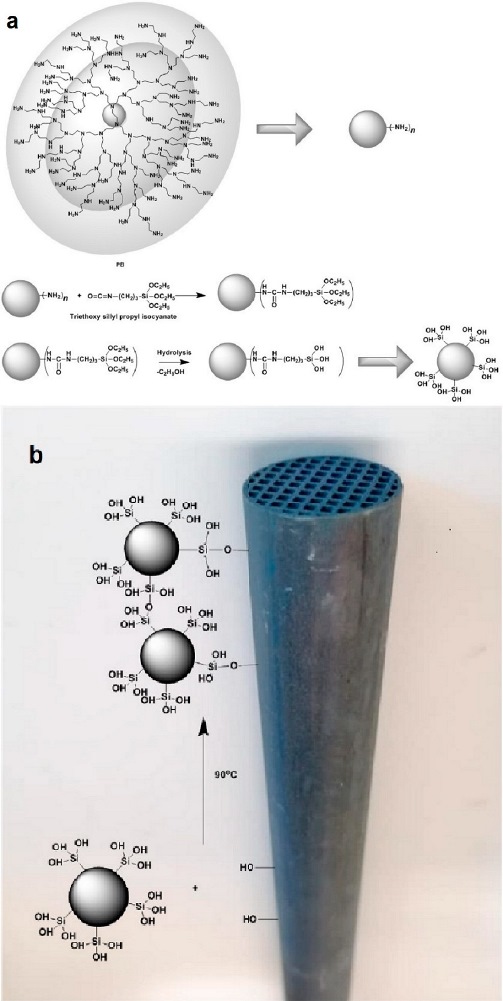Water purification employing dendritic polymers
Dendritic polymers came to the fore in the last 20 years and opened up new horizons to applications requiring, among others, outstanding adsorption properties. In this context, nanomaterials deriving from these tree-shaped structures were examined as potential solutions for the elimination of a variety of water pollutants.1-4 Dendrimers and hyperbranched polymers with octyl or octadecyl chains form films by evaporation of their chloroform solutions and adsorb polycyclic aromatic hydrocarbons (pyrene, fluoranthene, phenanthrene) to the level of few ppb.5-6 Further alternative routes include chemical bonding, cross-linking that immobilizes dendritic polymers on porous substrates and β-cyclodextrin siloxane derivatives impregnated in different porous ceramic materials (Al2O3, SiC, TiO2)7-9 and biomimetic formation of ceramic nano-shells around the dendritic adsorbent.10 Continuous filtration experiments for PAH, BTX, MTBE and pesticides reveal the quantitative superiority of dendritic polymers and highlight the importance of the contact time of the polluted water with the organic nanosponges.11

Relevant Publications
- M. Arkas, D. Tsiourvas and C. M. Paleos, Functional Dendrimeric "nanosponges" for the removal of polycyclic aromatics hydrocarbons from water. Chem. Mater. 2003, Vol 15, No 14, pp 2844-2847.
- M. Arkas, C. M. Paleos, L. Eleades and D. Tsiourvas, Alkylated Hyperbranched Polymers as molecular nanosponges for the Purification of Water from Polycyclic aromatic Hydrocarbons. J. Appl. Polym. Sci. 2005, Vol 97, No 6, pp. 2299-2305.
- M. Arkas, C. M. Paleos, and D. Tsiourvas, Organosilicon dendritic networks in porous ceramics for water purification Chem. Mater. 2005, Vol 17, No 13, pp. 3439-3444.
- M. Arkas ,R. Allabashi, D. Tsiourvas, E.-M. Mattausch , R. Perfler Organic/inorganic hybrid filters based on dendritic and cyclodextrin “nanosponges” for the removal of organic pollutants from water Environ. Sci. Techol. 2006, Vol 40 (8), pp. 2771-2777.
- R. Allabashi, M. Arkas, D. Tsiourvas, and Hörmann, G., Removal of some organic pollutants in water employing ceramic membranes impregnated with cross-linked silylated dendritic and cyclodextrin polymers, Water Res. 2007, Vol 41 (2), pp. 476-486.
- A. Tsetsekou, M. Arkas, A. Kritikaki, S. Simonetis and D. Tsiourvas, Optimization of hybrid hyperbranched polymer/ceramic filters for the efficient absorption of polyaromatic hydrocarbons from water J. Membrane Sci. 2008, Vol 311 (1-2), pp. 128-135.
- M. Arkas and D. Tsiourvas Organic/inorganic hybrid nanospheres based on hyperbranched poly(ethylene imine) encapsulated into silica for the sorption of toxic metal ions and polycyclic aromatic hydrocarbons from water J. Hazard. Mater. 2009 Vol 170 (1), pp. 35-42.
- M. Arkas, D. Tsiourvas, C.M.Paleos Functional dendritic polymers for the development of hybrid materials for water purification Macromolecular Materials and Engineering 2010 Vol 295 (10) , pp. 883-898.
- D. Tsiourvas, M. Arkas, C.M. Paleos Organic/Inorganic Hybrid Materials Based on Functional Dendrimers and Hyperbranchd Polymers for Water Purification. (Ed. Kostas Demadis) Chapter 13 pp 333-356 in the book Water Treatment Processes 2013 Nova Science Publishers. New York.
- M Arkas, K. Panagiotaki, I. Kitsou, F Petrakli, F. Dendritic Polymer—Enhanced Ultrafiltration. In Nanoscale Materials in Water Purification 2019, Chapter 5, 111-152. Elsevier.
- M Douloudi, E Nikoli, T. Katsika, M. Vardavoulias, M Arkas, Dendritic Polymers as Promising Additives for the Manufacturing of Hybrid Organoceramic Nanocomposites with Ameliorated Properties Suitable for an Extensive Diversity of Applications. Nanomaterials 2021, 11 (1), 19. https://doi.org/10.3390/nano11010019.
- Douloudi, M., Nikoli, E., Katsika, T., & Arkas, M. (2023). Dendritic polymers for water resources remediation. In Novel materials for environmental remediation applications (pp. 435-490). Elsevier.
- Arkas, M., Giannakopoulos, K., Favvas, E. P., Papageorgiou, S., Theodorakopoulos, G. V., Giannoulatou, A., ... & Pashalidis, I. (2023). Comparative study of the U (VI) adsorption by hybrid Silica-hyperbranched poly (ethylene imine) nanoparticles and xerogels. Nanomaterials, 13(11), 1794.
- Ioannidis, I., Pashalidis, I., & Arkas, M. (2023). Actinide Ion (Americium-241 and Uranium-232) Interaction with Hybrid Silica–Hyperbranched Poly (ethylene imine) Nanoparticles and Xerogels. Gels, 9(9), 690.
- Ioannidis, I., Aristotelous, E., Pashalidis, I., Dosche, C., Giannakopoulos, K., Karastergiou, E., & Arkas, M. (2024). Supreme capture of Europium (ΙΙΙ) by silica-hyperbranched poly (ethylene imine) composites from aqueous solutions− A mechanistic study. Journal of Molecular Liquids, 410, 125628.
- Arkas, M., Anastopoulos, I., Giannakoudakis, D. A., & Pashalidis, I. (2025). Nanoscale Materials for Water Purification and Catalysis. Nanomaterials, 15(13), 1019.